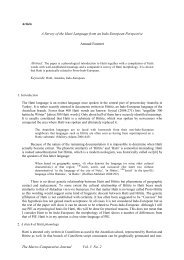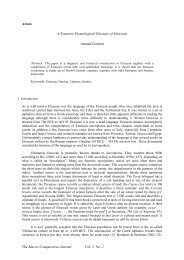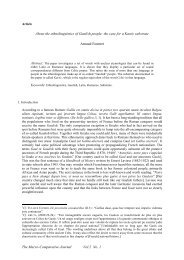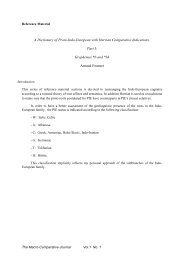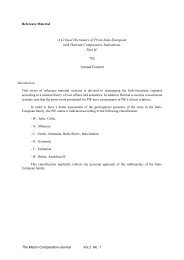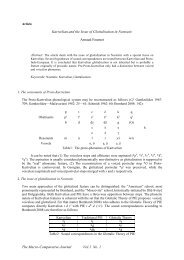The Kassite Language In a Comparative Perspective with
The Kassite Language In a Comparative Perspective with
The Kassite Language In a Comparative Perspective with
You also want an ePaper? Increase the reach of your titles
YUMPU automatically turns print PDFs into web optimized ePapers that Google loves.
<strong>The</strong> <strong>Kassite</strong> <strong>Language</strong><br />
Ku-ub-ši-ia-Sah ‘Tsah Verb(?)'s (?)’ Clay (2009:38).<br />
Ku-ub-ši-nim-gir ‘(?)’ Clay (2009:38).<br />
Ku-ru-uš-ni ‘(?)’ Clay (2009:38).<br />
Ta-ku-ša-Ḫar-be ‘Harbe (?)’ Clay (2009:37).<br />
U-zi-ši-Sah ‘Tsah protected (?) you’ Clay (2009:41).<br />
Examples of -š- as final “apparent” formative:<br />
Bur-za-ra-aš ‘(?)’ Clay (2009: 36).<br />
Bu-še ‘(?)’ Clay (2009:37).<br />
Gan-daš ‘(?)’ Clay (2009:37).<br />
Ḫar-bu-uk-šu ‘(?)’ Clay (2009: 37).<br />
Ḫa-ra-ak-ši ‘(?)’ Clay (2009: 37).<br />
Ka-ra-in-da-aš ‘(?)’ Clay (2009:37).<br />
Ka-ra-har-da-aš ‘(?)’ Clay (2009:38).<br />
This formative -š- seems to freely combine <strong>with</strong> <strong>Kassite</strong> forms like Sah, Harbe, etc. It also<br />
combines <strong>with</strong> the formative -nta: Karai-nda-š ~ Ar-š-anta. A possibility is that -š- represents P2Pl<br />
while nta is P1Pl.<br />
Another conclusion is that Afrasian emphatics should correspond <strong>with</strong> PIE so-called voiced<br />
aspirate series rather than <strong>with</strong> the (trad.) voiced series, as the Glottalic theory proposes.<br />
5. Glossary<br />
It is possible to resort to the well-established combinatory procedure to test our working hypothesis<br />
against potential <strong>Kassite</strong> words and person names.<br />
A<br />
*[ab-] ‘first (?)’. Cf. Hurrian abi- ‘head; first’ (Laroche 1980:34).<br />
A-ba-am-ba ‘you are the first one (?)’ NPN (198, 200-1, 243).<br />
A-pa-a-a ‘he is the first one (?)’ NPN (201-2).<br />
A-ba-ri-du-ru-uk ‘the male one came first (?)’ NPN (202). A case of -ri- for Past (?).<br />
A-be-ia ‘He verb(?)-s him’ NPN (201).<br />
A-bi-en-na-a-an-né-en ‘<strong>The</strong>y verb(?) them’ NPN (201).<br />
A-bi-an-ni ‘<strong>The</strong>y come to verb(?)’ NPN (201).<br />
A-bi-ha-ri ‘(?)’ Clay (2009:37).<br />
*[ag-] ‘(?)’. Cf. Hurrian ag- ‘to lead’ (Laroche 1980:36).<br />
A-ki-be-(e)-i ‘She brings you (?)’ NPN (198).<br />
A-ki-a-a-an-ni ‘<strong>The</strong>y bring him (?)’ NPN (198).<br />
A-ki-ia ‘He brings him (?)’ NPN (198).<br />
A-ki-ib-ba-šá-ah ‘Tsah brings you (?)’ NPN (198).<br />
f A-gi-im-ni-nu ‘<strong>The</strong>y brought her (?)’ NPN (198).<br />
A-gu-um ‘(?)’ Clay (2009:36). This name does not fit the usual bi-morphemic pattern. NPN (198) is<br />
of no clear avail.<br />
Aq-ri-ia-aš ‘he leads the lands (?)’ Clay (2009:36, 37). Cf. Hurrian ag- ‘to bring, to lead’ (Laroche<br />
1980:36).<br />
*[aγ-] ‘(?)’. Possibly not a verb because of the absence of valency.<br />
Ah-ha-ar-pa ‘Harba (= Enlil) is (?)’ NPN (198).<br />
Ak-mu-ul ‘(?)’ Clay (2009:36). Attested in Bur-ru-ak-mu-ul ‘strong is Akmul (?)’. Cf. Kamulla.<br />
*[al-] ‘(?)’. Cf. Hurrian al- ‘(1) to bring near to, (2) to speak’ (Catsanicos 1996).<br />
A-li-ib-bi-ia ‘He brings you (?)’ NPN (199).<br />
A-al-li-ia ‘He brings him (?)’ NPN (199).<br />
*[al-b-] ‘(?)’. Cf. Hurrian al- ‘(1) to bring near to, (2) to speak’ (Catsanicos 1996).<br />
Al-ba-di-Sah ‘Tsah brought me (?)’ Clay (2009:36).<br />
<strong>The</strong> Macro-<strong>Comparative</strong> Journal Vol.2 No. 1 6



